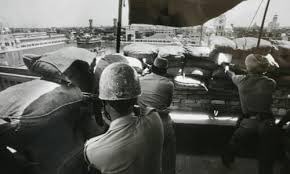On 5 June 1984, the Indian Army continued their relentless firing at the Sri Darbar Sahib complex and over 10,000 Sikhs trapped inside. At 6.30am, their bullets hit and killed Amrik Singh, the 65 year old blind Head Ragi. Another Ragi, Avtar Singh, took a fatal bullet soon after. 







Helicopters continued to circle above, spraying the Darbar Sahib complex with artillery fire, killing Sikh civilians indiscriminately. At 11.30am, the water tank inside the complex was fired at, and then bombed, completely destroying it.
The valiant Sikh warriors who had taken positions beneath the tank while defending the complex attained Shaheedi.
The Indian Army continued their attack until evening, unable to break through the defence the brave Sikh warriors had mounted to protect their holy shrine.
The Indian Army continued their attack until evening, unable to break through the defence the brave Sikh warriors had mounted to protect their holy shrine.
At 7pm on 5 June 1984, a full scale invasion of Sri Darbar Sahib began and the Indian Army commenced an unprecedented attack against its own citizens; the very people it was supposed to protect.
38 tonne Vijayanta tanks fitted with 105mm heavy guns,
38 tonne Vijayanta tanks fitted with 105mm heavy guns,
from the 16th Cavalry Regiment of the Indian Army, moved to enclose the Darbar Sahib complex.
Witnesses state thirteen tanks were used in the attack that night, in addition to eight BMP infantry carrying vehicles, three Armoured Personnel Carriers, and helicopters.
Witnesses state thirteen tanks were used in the attack that night, in addition to eight BMP infantry carrying vehicles, three Armoured Personnel Carriers, and helicopters.
At 8pm, the Indian Army breached the complex under heavy cover fire. No one was allowed to exit the complex. The attack was not preceded by warnings or announcements asking people to surrender. At 9pm, the power was cut to Amritsar and the entire city was plunged into darkness.
At 10pm, the tanks started entering the complex and the barrage of fire intensified as heavy armour began to be used. There were instances of artillery shells landing more than 5km away in the crowded city.
Amritsar was shaken by intense shelling, mortar explosions and
Amritsar was shaken by intense shelling, mortar explosions and
machine gunfire. Tracer bullets and flares lit up the sky. The explosions from Darbar Sahib rattled doors and windows miles away. While the invasion was raging, the state operated radio stations falsely claimed that the city was ‘calm’.
At 10.30pm, an armoured carrier entered the complex and stood beside the Sarovar. The lights on the carrier bathed the whole complex in bright light. Sikh pilgrims mistook it for a firetruck, thinking it had come to get water to extinguish the fires raging throughout the city.
But they were proven wrong. The carrier came down the Parikrama & started firing. The tanks started closing in, their artillery setting fire to buildings while desperate civilians collected water from the Sarovar to extinguish them. Loud cries of women & children pierced the air.
Every Sikh pilgrim inside the Darbar Sahib was treated as the enemy; to be shot and killed if possible, or to be denied first aid, or even water, if wounded. At one point during the evening, a large number of men, women and children had gathered in an open compound.
The Indian Army threw a grenade at these civilians, resulting in the massacre of the entire group who had come to pay obeisance for Sri Guru Arjan Dev Ji’s Shaheedi Diwas just a day earlier.
The bloodshed and massacre of Sikhs wasn’t just limited to the Darbar Sahib complex.
The bloodshed and massacre of Sikhs wasn’t just limited to the Darbar Sahib complex.
That night, a Hindu home behind the complex caught fire after being hit by artillery. The father sent his two teenage sons to the nearby square to get water. The boys arrived there to find that the Army had rounded up 14 Sikh youth & were about to shoot them with Sten gun fire.
The Hindu boys too were bundled alongside the Sikhs by the soldiers, and only when they pleaded that they were Hindu, and had come to get water to put out a fire in their home, were they spared. The soldiers then opened fire on the 14 Sikh boys, killing them instantly.
Hearing the sounds of the invasion, Sikhs from Amritsar and its surrounds began to march towards Darbar Sahib in a bid to protect their holiest of shrines. Throughout the night, Jaikaras were heard from the Sikhs trying to march to Darbar Sahib from three different directions.
Their Jaikaras were heard briefly, before being followed by rapid army machine gun fire each time.
Bhai Nirmal Singh Ji Khalsa, a Hazoori Ragi who sat on a rooftop overlooking Darbar Sahib, saw Sikhs approaching the complex being executed in the streets by the Indian military.
Bhai Nirmal Singh Ji Khalsa, a Hazoori Ragi who sat on a rooftop overlooking Darbar Sahib, saw Sikhs approaching the complex being executed in the streets by the Indian military.
• • •
Missing some Tweet in this thread? You can try to
force a refresh

 Read on Twitter
Read on Twitter












